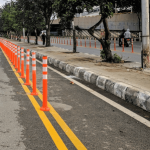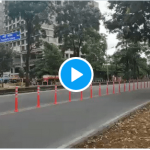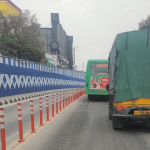By Anuksha Dey
Within a week after the cycle lane on Race Course Road was inaugurated, questions about the design of the cycle track raise concerns for pedestrians as well as activists. Citizens also take to social media about construction work in other parts of the city.
Bengaluru’s Smart City Project
The cycling track is part of the government’s initiative to transform Bengaluru into a smart city. The cycle lanes will provide a safer, more environment-friendly mode of transportation in the city centre and help connect Palace Road with Race Course Road.
The Smart City Project is a nationwide urban renewal programme launched by the central government. In Bengaluru, the project aims to upgrade the infrastructure of the city and make it more user-friendly, with a special emphasis on improvements of roads, pavements, public transport, parks, and street lights. The areas located around Bengaluru are expected to grow as a result of the “trickle-down effect” once it is developed into a smart city.
Ongoing work in the city centre
The Race Course Road cycle lane lies to the north of Cubbon Park, a hub for Bengaluru’s cyclists. The cycle track is yet to be linked to other parts of the city. The cycle track on Race Course Road will eventually connect to Palace Road, Raj Bhavan Road and Chalukya Circle. However, BBMP officials are unsure about the timeline. But work on Phase 2 of the cycle lane project has begun near Raj Bhavan. The cycle track at Raj Bhavan will meet the Race Course Road at Basaveshwara Circle.
Another cycle lane is being made at Rhenius Street in Richmond Town as shown in the picture below.
Concerns about the practicality of the design
The cycle lane initiative has been widely applauded by Bangaloreans as well as people from other states who want the project replicated in their cities. However, the design has raised many concerns. The cycle lane has been created by cordoning off a section of the footpath, leaving pedestrians disgruntled.
According to Arun Kumar, “There is hardly any space for pedestrians at multiple places as trees are blocking the path.” The Directorate of Urban Land Transport states: “We have taken the cycle tracks behind bus stops and places where large trees are, to avoid conflicts and to provide continuity of cycle tracks.”
However, ChangeMakers of Kanakapura Road, a citizen-led volunteer’s group from Kanakapura Road point out that “this design may cause a lot of pedestrian, cyclist conflicts. The random curve is where the pedestrian has to cross from one side to another. The zebra crossings should also come on the cycle lane so that cyclists can slow down.”
Previous Cycling Lane Project on ORR
Bengaluru opened its first cycling lane on the Outer Ring Road in October last year. The Pop-up cycle lane, however, has been invaded by motorcyclists due to lack of monitoring. Better infrastructure and police involvement is required at the city centre to ensure that the new cycle lanes do not suffer the same fate as its counterpart on Outer Ring Road.
The cycle lane, a timely initiative
The cycle lane comes at a time when the number of cycles being sold across India is at a record high. The pandemic increased cycle sales by two-fold at the end of October 2020. Social distancing has made cycles the most practical alternative for those who previously travelled by public transport. With more cyclists in India than ever, a better-connected city centre and a safer route will surely help Bengaluru traffic in the long run, if maintained properly.



